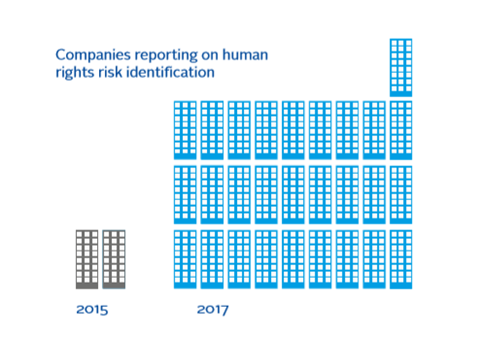High-level trends
Human rights risk assessment - identifying
- In 2015, two companies reported on human rights risk identification; this increased to 25 in 2017, making it one of the most improved areas. Almost all target companies have incorporated human rights considerations into their risk management processes and evaluated their potential human rights impact from the project development stage and throughout all subsequent stages.
Human rights risk assessment - assessing
- The number of companies that proactively assess potential human rights risks and actual human rights impact both before a new operation is launched and throughout the life cycle of the project has significantly increased. In 2015 only two companies reported on human rights risk assessments – in 2017 two thirds of the target companies did.
Human rights risk assessment - integrating and acting
- While only one company reported on this indicator in 2015, more than a third of them now do. This upward trend is mostly attributed to an improvement in disclosure among mining companies and companies from developed markets, with almost half of both now reporting on how they integrate and act upon the findings drawn from their human rights impact assessments. Progress has been less substantial among oil and gas companies, and as of 2017, no company from the emerging markets has started to report on this indicator.

Human rights risk assessment - tracking
- Similar to the integrating and acting KPI, disclosure in public reporting has been led by mining companies and companies from developed markets. Ten companies now report on how they track the effectiveness of the actions taken in response to their actual and potential human rights impacts.
Human rights risk assessment - communicating
- Although nine companies now report on this KPI, against one in 2015, the smallest improvement in disclosure was registered for this indicator. Mining companies and those from developed markets have scored significantly better than oil and gas and emerging markets companies. It is also worth noting that smaller companies have also scored substantially better than their larger counterparts.
Good practice: human rights risk assessment, identifying
Freeport-McMoran has a sustainable development risk register that considers human rights impact at the scoping stage and integrates the UNGPs into their system to improve management of potential human rights risks. The company has a corporate HRIA and has tailored HRIAs to specific sites – for operations in the Democratic Republic of Congo, for example. Besides, an online due diligence platform was launched, the Freeport Compliance eXchange (FCeX) – a survey-based software platform designed to assess human rights related risks among others. For example, for the Cerro Verde HRIA, extensive on-the-ground engagement with stakeholders is conducted to verify the desk-based initial assessment of potential human rights risks and impacts and capture less visible risks and impacts.

What should investors look out for?
Human rights risk assessment - identifying
- Risk identification process does not incorporate exogenous factors (geography, socio-economic conditions etc.).
- Lack of focus on the most salient human rights risks.
- Human rights risks are not incorporated into the risk management system.
- Human rights risks are considered only on the company’s own operations – potential risk or impact through relevant business relationships are not assessed.
- Human rights risk identification is not tailored to specific stages of the projects/to changes in activities (entering a new market, launching a new project etc.).
Good practice: human rights risk assessment, assessing
Barrick Gold hires an independent consulting firm to conduct their human rights impact assessments. The firm assesses the actual, potential and perceived human rights risks and impacts at high-level risk operations and advanced projects. An NGO also serves as an independent advisor and in-depth assessments of applicable country-level risks are provided by the Danish Institute for Human Rights. The company adopts a holistic approach to risks and impacts assessment and conducts interviews with relevant stakeholders (both internal and external). The results of their human rights impact assessments are made available on the website along with some of the steps taken to mitigate these risks.
Human rights risk assessment - assessing
- Absence of a process to assess human rights risks taking into account relevant factors (geography, socioeconomic conditions, etc.).
- Salient human rights risks are assessed once – no process to review and adapt them to changing circumstances is in place.
- The company does not disclose the findings of human rights risk assessments.
Human rights risk assessment - integrating and acting
- No internal process is in place to integrate findings of human rights impact assessments (HRIA) into relevant internal functions.
- No action plan is in place to prevent, mitigate or remediate the most salient human rights issues identified and assessed through the HRIA.
Human rights risk assessment - tracking
- No system to track effectiveness of action plan to respond/mitigate/remediate potential or actual human rights risks identified through HRIA.
- The company tracks effectiveness of action plan on an ad-hoc basis but does not integrate lessons into overarching internal risk management process.
Good practice: human rights risk assessment, tracking
Barrick Gold: Once information on human rights risks is gathered and assessed, a final report is issued and an action plan proposed. The proposed action plan is then reviewed, adjusted and adopted by local management and other relevant personnel. Once finalised, action plan items are included in a data tracking system which automatically sends follow-ups to accountable employees to ensure the plan is executed.
Human rights risk assessment - communicating
- How the company addresses its human rights impact is only communicated internally – relevant external stakeholders are not informed.
- No criteria is set to decide what to communicate, to whom, when and how in response to actual or potential human rights impacts.
- Communication is made without addressing the potential information and barriers affected external stakeholders may face, e.g. the company does not tailor its communication to the potentially affected stakeholders and information is not translated into local language.
Good practice: human rights risk assessment, communicating
Goldcorp has communicated extensively around its human rights impact assessment at the Marlin Mine and is one of the only companies to disclose their actual impact assessment. Their disclosure includes an overview of the legal cases involving the mine, a summary of findings by human rights, and an external hazard assessment of chemical constituents.
Download the full report
-

Digging deeper: human rights and the extractives sector
July 2018
Human rights and the extractives industry
- 1
- 2
- 3
- 4
- 5
- 6
- 7
- 8Currently reading
Engagement against objectives: human rights risk assessment
- 9













